Authors
J. J. Luszczki, S. L. Kocharov, S. J. Czuczwar.
Lab
Medical University, Department of Pathophysiology, and Institute of Agricultural Medicine, Department of Physiopathology, Lublin, Poland.
Journal
Neuroscience Research
Abstract
The aim of this study was to determine the influence of N-(anilinomethyl)-p-isopropoxyphenylsuccinimide (AMIPPS) on the protective action of carbamazepine, phenobarbital, phenytoin, and valproate in the mouse maximal electroshock seizure model. Results indicate that AMIPPS administered separately (i.p., at doses of 75 and 150 mg/kg), significantly elevated the threshold for electroconvulsions in mice. Moreover, AMIPPS (37.5 mg/kg) significantly enhanced the anticonvulsant activity of phenobarbital and valproate, but not that of carbamazepine or phenytoin in the maximal electroshock seizure test in mice. AMIPPS (18.75 mg/kg) had no impact on the antiseizure action of phenobarbital and valproate against maximal electroshock seizure-induced seizures in mice. Pharmacokinetic experiments revealed that AMIPPS significantly increased total brain valproate concentrations and it had no impact on total brain concentrations of phenobarbital in mice. In conclusion, the enhanced antielectroshock action of phenobarbital by AMIPPS and lack of pharmacokinetic interaction make the combination of AMIPPS with phenobarbital of pivotal importance for further experimental and clinical studies. Although AMIPPS potentiated the anticonvulsant action of valproate in the maximal electroshock seizure test, the caution is advised when combining these drugs due to the risk of pharmacokinetic interactions. The combinations of AMIPPS with carbamazepine and phenytoin are neutral from a preclinical viewpoint.
BIOSEB Instruments Used
Grip strength test (BIO-GS3)
Source :
http://www.sciencedirect.com/science/article/pii/S016801020900090X

 Douleur - Allodynie/Hyperalgésie Thermique
Douleur - Allodynie/Hyperalgésie Thermique Douleur - Spontanée - Déficit de Posture
Douleur - Spontanée - Déficit de Posture Douleur - Allodynie/Hyperalgésie Mécanique
Douleur - Allodynie/Hyperalgésie Mécanique Apprentissage/Mémoire - Attention - Addiction
Apprentissage/Mémoire - Attention - Addiction Physiologie & Recherche Respiratoire
Physiologie & Recherche Respiratoire




































 Douleur
Douleur Système Nerveux Central (SNC)
Système Nerveux Central (SNC)  Neurodégénérescence
Neurodégénérescence Système sensoriel
Système sensoriel Système moteur
Système moteur Troubles de l'humeur
Troubles de l'humeur Autres pathologies
Autres pathologies Système musculaire
Système musculaire Articulations
Articulations Métabolisme
Métabolisme Thématiques transversales
Thématiques transversales Congrès & Meetings
Congrès & Meetings 